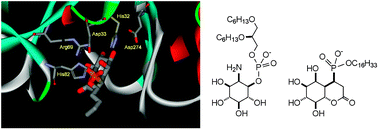Abstract

- This article is part of the themed collection: Biophosphates
* Corresponding authors
a
Department of Medicinal Chemistry and Pharmacognosy, University of Illinois at Chicago, Chicago
E-mail:
kbruzik@uic.edu
b Department of Chemistry, The Ohio State University, Columbus, Ohio 43210
c Department of Natural Sciences, Northwestern Oklahoma State University, Alva
d Department of Molecular Biology, The Scripps Research Institute, La Jolla
e Institute of Biological Chemistry, Academia Sinica, Taipei 115, Taiwan

 Please wait while we load your content...
Something went wrong. Try again?
Please wait while we load your content...
Something went wrong. Try again?
C. Mihai, X. Yue, L. Zhao, A. Kravchuk, M. Tsai and K. S. Bruzik, New J. Chem., 2010, 34, 925 DOI: 10.1039/B9NJ00629J
To request permission to reproduce material from this article, please go to the Copyright Clearance Center request page.
If you are an author contributing to an RSC publication, you do not need to request permission provided correct acknowledgement is given.
If you are the author of this article, you do not need to request permission to reproduce figures and diagrams provided correct acknowledgement is given. If you want to reproduce the whole article in a third-party publication (excluding your thesis/dissertation for which permission is not required) please go to the Copyright Clearance Center request page.
Read more about how to correctly acknowledge RSC content.
 Fetching data from CrossRef.
Fetching data from CrossRef.
This may take some time to load.
Loading related content
